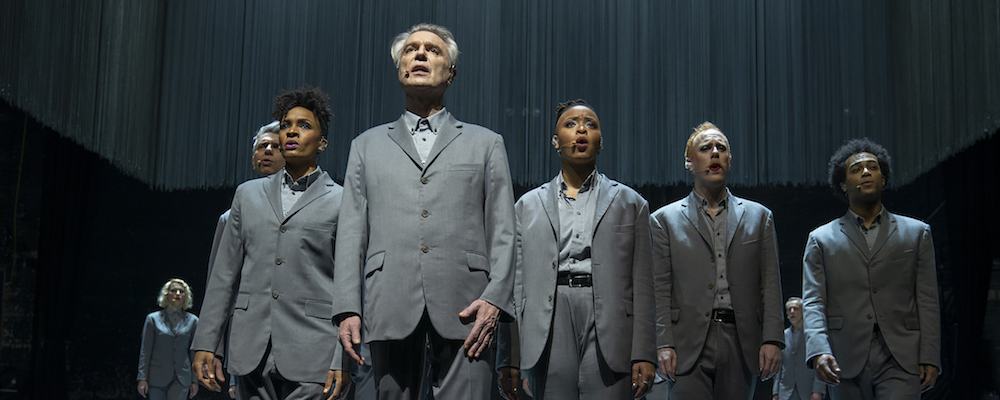In Spike Lee-Directed ‘American Utopia,’ David Byrne Powerfully Transcends the Stage
Alci Rengifo
A profound live show can become a transcendental experience, combining performance and sound into something akin to secular spiritualism. Spike Lee’s dazzling chronicle of “David Byrne’s American Utopia” also proves a great filmmaker can capture that very feeling. In 2013 Talking Heads frontman David Byrne made an album with the legendary Brian Eno, “American Utopia,” which received strong reviews even before Byrne turned it into a hit Broadway performance. This is in essence the third reiteration of the concept, and also a fresh rebirth. Lee is not out to simply film Byrne’s stage performance, but to combine its art with his craft, thus transforming it into its own, stunning piece.
Lee’s cameras filmed “American Utopia” performances in late 2019 and early 2020, just before the pandemic would have rendered such a feat impossible. Staged at Broadway’s Hudson Theatre in New York City, “American Utopia” is David Byrne’s celebration of various elements, ranging from diversity to the sheer power of live human expression. The set is bare, consisting of mostly grey backgrounds and light curtains. Byrne and the musicians and dancers accompanying him are dressed in simple, grey suits. They have no need for elaborate set designs to distract the eyes of the audience. Byrne commences the show with “Here,” then shares about the intricacies of the human brain and how we lose cells as we grow older. Yet these cells also connect us all, because it’s part of our collective anatomy. What follows is a show where music and ideas combine as pure expression, flowing from theme to theme, sometimes explicitly made, other times evoked through the songs. Byrne and his band mix songs from the “American Utopia” album with Talking Heads classics and selections from Byrne’s solo work. It all comes together to envelop the viewer and audience into the sheer joy of creativity.
Beginning with the title, “American Utopia” can mean many things, but none without powerful merit. What Byrnes and his fellow musicians create on stage as captured by Lee is a form of utopian freedom. Artificial divisions, prejudices and inhibitions seem to dissipate inside the Hudson Theatre. Byrne turns Talking Heads favorites like “Once in a Lifetime” into renewed, grandiose numbers where his vocal power soars as well as his sense of the theatrical. He evokes the Dadaists before breaking into an exhilarating rendition of “I Zimbra,” discussing how Dada founder Hugo Ball believed in using “nonsense” speak to challenge a world gone mad. A performance of Byrne’s solo track “Lazy” turns the song into a near celebration of doing your own thing in an oppressive world. “Toe Jam” shows off the band’s magnificent skills with irresistible fun. Everyone from the percussionists to the backup vocalists seems to suddenly be gifted with the world’s most skilled dancing toes.
Other moments take on a very self-reflective ambiance, as when Byrne remembers buying a small television with his first, small earnings from Talking Heads’ first record deal in 1976. Then he performs “I Should Watch TV,” staring into a curtain emitting the faint glow of a television screen. “Bullet” is sung with Byrne holding a light that looks like a torch in a dark street. “This Must Be the Place” takes on a breezy feel, with the band moving with Byrne in precise choreography. Lee’s camera is never intrusive, but the shots and editing build to an exhilarating, almost feverish momentum during the whole show. He can frame a dance move or Byrne’s profile with the same, exquisite precision of his feature films. Overhead shots of certain moments enhance a number in a way an audience member, even with the best seats, could never experience. Lee is making a cinematic work out of Byrne’s show, conjuring the very freedom the performances seem to burst with.
Byrne does not shy away from breaking through the idea of utopia to also make urgent pleas with a social conscience. He will pause the music to urge audience members to vote, lament climate change and celebrate the diversity of his musicians who come from a wide range including Colombia, France, Brazil, California and New Jersey. They are all masterful players and performers, and that is part of the point of the show’s idea of utopia: The music itself erases their labels. But Byrne’s most powerful social statement is a blistering performance of Janelle Monae’s protest anthem “Hell You Talmbout,” where the names of murdered Black Americans are called out. And while this was always part of the original Broadway show, it is also another testament to Spike Lee continuing to be a filmmaker unafraid to make clear, powerful statements in his work, forever and urgently commenting on the times.
Byrne has always had some link to excellent filmmaking. With Talking Heads the New Wave icon was already immortalized in “Stop Making Sense,” one of the great concert films, directed by the late Jonathan Demme. “American Utopia” is something much richer and mature in terms of themes and execution however. Older, greyer, Byrne’s talent remains powerfully intact, as evident in the roaring performance of “Burn Down the House,” but he also achieves something quite transcendental. This is not a film about a performance, but about the art of performing and constructing a sort of communion with your audience. Combined with Lee’s direction, we feel part of the show, not as mere spectators.
Watch “American Utopia” because it is so enjoyable and immersive. It is a combination of great artists at the top of their game, collaborating to make a work that sings, dances and grabs you with its visual energy. If we have yet to achieve any semblance of utopia in our world, at least we can feel it when the lights go down and the stage becomes its own promising world.
“David Byrne’s American Utopia” airs Oct. 17 at 8 p.m. ET on HBO.

